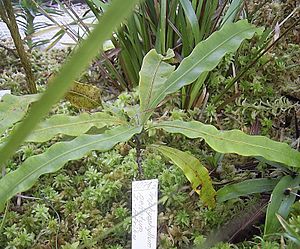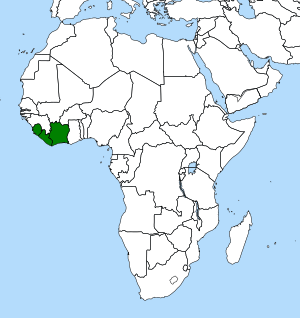Triphyophyllum facts for kids
Quick facts for kids Triphyophyllum |
|
|---|---|
 |
|
| Scientific classification | |
| Genus: |
Triphyophyllum
|
| Species: |
peltatum
|
 |
|
| Triphyophyllum distribution | |
| Synonyms | |
|
|
Triphyophyllum peltatum is a very special plant. It is a carnivorous plant, which means it eats insects! This plant is the only known species in its genus, Triphyophyllum.
You can find Triphyophyllum peltatum growing in the warm, wet tropical rainforests of western Africa. Specifically, it lives in countries like Sierra Leone and Liberia.
Contents
Meet Triphyophyllum peltatum
This unique plant is a type of liana. A liana is a woody vine that climbs up other plants to reach sunlight. What makes Triphyophyllum peltatum so interesting is its amazing life cycle. It goes through three very different stages as it grows. Each stage has a different kind of leaf. This is why it's called Triphyophyllum, which comes from Greek words meaning "three leaves."
Its Amazing Life Cycle
Stage 1: The Young Plant
When Triphyophyllum peltatum is young, it looks quite ordinary. Its leaves are simple and shaped like a spear. At this stage, it doesn't stand out much from other plants around it.
Stage 2: The Sticky Trap
Next, the plant enters its second stage. This is where it becomes a carnivorous plant! It grows long, sticky leaves. These leaves are covered in special glands that produce a gooey substance. Insects get stuck to these leaves, and the plant then digests them for nutrients. This stage is similar to how another carnivorous plant, Drosophyllum, catches its food.
Stage 3: The Climbing Vine
Finally, Triphyophyllum peltatum reaches its adult stage. It stops being carnivorous. Instead, it grows into a long, twining stem. This stem helps the plant climb high into the rainforest canopy. The leaves in this stage are short and no longer sticky. They are just regular leaves that help the plant make food from sunlight.
Where to See This Rare Plant
Triphyophyllum peltatum is a very rare plant. It is not easy to find in nature, and even harder to find in gardens. Only three special botanical gardens around the world grow this plant. You can see it in Abidjan (a city in Africa), Bonn (in Germany), and Würzburg (also in Germany). It is almost never found in private plant collections.
See also
 In Spanish: Triphyophyllum peltatum para niños
In Spanish: Triphyophyllum peltatum para niños

